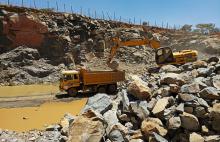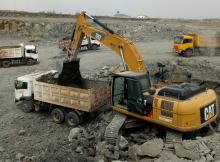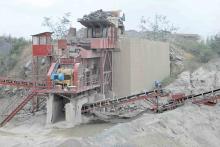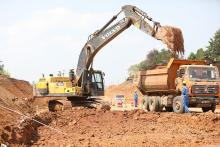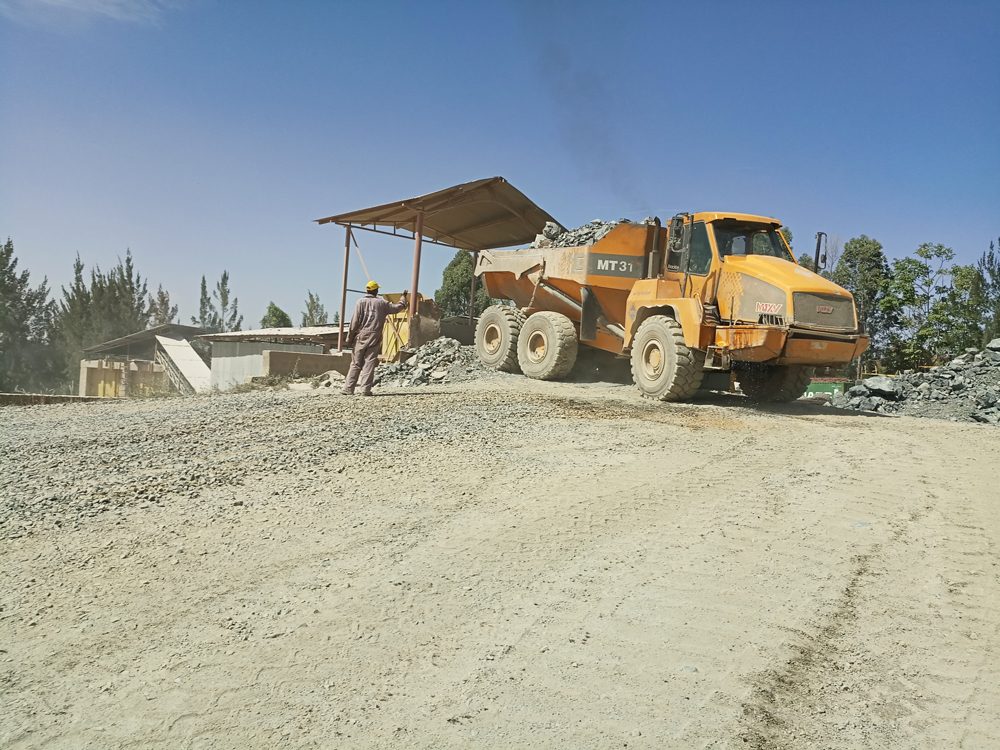
A Sirikwa Quarry Ltd, the largest quarry in Uasin Gishu county, believes it has what it takes to meet Eldoret’s increasing demand for various types of construction material, including the short notice supply of ballast for roads construction and buildings.
“The current market for ballast in Eldoret is big and all our production is consumed within this growing town,” says Vipin Makwana, the quarry’s manager.
Located a few metres from the Eldoret central business district on the Nairobi-Malaba highway, Sirikwa Quarry sits on a 50ha piece of land which Makwana says “was so quiet with no single construction around or building near when we opened the site 31 years ago.”
It is easy to underestimate the hive of activity behind the tall concrete wall that shields Sirikwa Quarry’s aggregates-covered compound grounds from view, as one drives along the Eldoret stretch of the Nairobi-Malaba highway.
But as one steps through the gates of Sirikwa Quarry, the view changes. Apart from the company’s offices built next to the main gate, the rest of the company’s land is either covered with various ballast sizes, quarry washed sand ready to deliver to customers, or busy loaders, dump trucks and the imposing primary and secondary crushing plant.
“I can say we are lucky to have picked this site as it is rich in rock, although ordinarily we have to drill to 10m-11m before we launch the blasting process,” says Makwana.
“The advantage we have is that the stone surface level is quite near the earth’s surface, so we do not have to drill more than the 10m-11m range,” he adds.
Makwana says a recent study initiated by Sirikwa Quarry Ltd. on the potential of the blasted, mined and cleared sections of the quarry indicates that “we have more rock 120m deep beneath the already mined areas of the quarry.”
At the quarry, ballast material for road building and building construction is produced in various sizes, depending on the final consuming industry. For road construction the quarry produces 0-4mm, 6-10mm, 10-14mm size ballast, while for building construction, Sirikwa produces sizes 10-14mm and 14-20mm.
“We use 0-6mm ballast for making blocks,” says Makwana. The quarry’s blocks are of 190mm x 190mm x 380mm size.
“The entire production process at the quarry begins with identification of a site to be drilled and blasted,” he says.
Sirikiwa uses Hitachi ZX 50 U-5 compact excavators and
Before the loading of the blasted material, the quarry uses handheld Atlas Copco drilling equipment to open up the rock for the insertion of detonators, or a mixture of ammonium nitrate and cordtex that Makwana says could be as much as 10-15kgs of explosives.
“The explosive-laden load in each drilled hole is connected to a wire that is tied together with others in all the drilled holes and covered with light soil before we carry out remote detonation,” explains Makwana.
The Hitachi or CAT excavators remove the blasted material and load it on to
“The Moxy dump trucks carry quite a large amount of load and are suitable for the tough operations at quarries such as Sirikwa,” says Makwana.
“The Hitachi wheeled loaders, which we mostly use to load the Moxy ADTs, load up to 4 tonnes of stone or ballast in one scoop,” he says. The Moxy ADTs have a maximum capacity of 25 tonnes.
The Moxy ADTs haul the rock to the primary crushing plant where the process of producing various ballast sizes begins.
“At the crushing plant we wash 0-4mm material to remove silt or fine powder,” says Makwana.
Sirikwa has installed a Metso crushing plant which Makwana says has been working well, producing the high quality aggregates that the quarry is known for. “The crushing plant and most of the rest of the equipment at the quarry run for eight to 10 hours,” he adds.
To enhance operations at Sirikwa, Makwana says they have had to acquire a higher spec Metso sand washing plant.
“The Metso equipment is the only washing machine for the production of quarry sand in Uasin Gishu and other neighbouring areas,” he says.
Makwana says the push for reduction in the use of river sand in Kenya could lead to increasing use of quarry sand.
“In Europe, where we imported the sand washing machine from, there is a total ban on the use of river sand,” he says. “In addition, we also replaced the primary crusher about two years ago, a decision we now think was best because of the increased performance of the equipment.”
Makwana says that the improved performance of Sirikwa’s primary crushing and washing plant equipment has boosted the company’s standing in the market, because it makes it easier for the quarry to maintain its quality of manufactured quarry sand.
“Consumers of our sand and even state agencies know that we are concerned about the environment and aware of the impact of river sand harvesting,” he adds.
In addition, Sirikwa has embraced water harvesting using specific tank storage units along with the open pits spread across the mined area. This has enabled them to better control dust levels.
“Dust suppression is very important for Sirikwa Quarry. It ensures compliance with environmental and health and safety regulations and reduces the risk to workers and other people, especially with the encroachment of residential and commercial settlements around the quarry,” he said.
The quarry has a big shallow pit where rain water collects. “We pump this water with an
Some of the main areas where water is sprayed either manually or using water spraying trucks are roadways within the quarry, the crushing plant and rock extraction points.
With a workforce of about 100 staff, Sirikwa produces an average of 500 tonnes of ballast/day, with some days seeing up to 800 tonnes produced.
The quarry’s production usually follows demand in the construction industry at both the regional and national level.
“The quarry’s production level was at its peak in the 2015/16 period because of a then booming construction industry,” says Makwana.
The 2016/17 production period was not very good for Sirikwa, probably because of the general business trend that saw a drop in consumption linked to Kenya’s general election and fear of the political unrest in the aftermath.
Makwana says it is still the case that fewer individuals or companies are putting up buildings, especially commercial premises, and few are buying land for commercial buildings. “Infrastructure projects are picking up but at a slow pace, hence the impact on our order book,” says Makwana.
Going forward, Makwana believes the market for construction material can either grow, if the regional and national economies improve, or stagnate should the economy’s take-off be delayed.
“It may be difficult to predict what trend the construction material will take, but my projection is there is likely to be growth. However, this again depends on how the economy performs,” he concludes.
“When the quarry was started 31 years ago there was not a single building, be it commercial or residential. It was an open plan field. Since then we have people who have bought property and land around the quarry and are exerting pressure on our operations, because they feel it should be re-located,” says Makwana.
“There are gaps in the current regulations on the relationship between quarries and commercial and residential buildings. This means that although the quarry could have potential to supply ballast for the next 50 years, we are not sure we could be at this site by that time.”
Makwana says that gaps need to be filled in current laws to regulate how people acquire land where there is an existing quarry. The Sirikwa quarry manager adds: “There is no regulation barring somebody from acquiring land next to a quarry and later turning around and demanding for the relocation of the quarry, despite its life being at its infancy.”
Makwana says there is a new challenge emerging in Kenya’s quarry business in the form of construction contractors who come with their own equipment. This includes mobile crushing plant that allow the contractor to prepare onsite building materials for use in construction projects, thus cutting substantial volumes traditionally supplied by quarry operators.
Sirikwa may consider expanding supply of its material outside Uasin Gishu, but Makwana says such a strategy may not make business sense.
“Distant markets are not easy to access, not because of the competition, but because transporting aggregates is expensive,” he explains.
“Actually, the cost of transportation is much higher than the cost of the material being transported, so it makes sense for quarry operators to concentrate on markets that are near the source of the construction material, which for Sirikwa Quarry is Eldoret town and Uasin Gishu county as a whole.”

